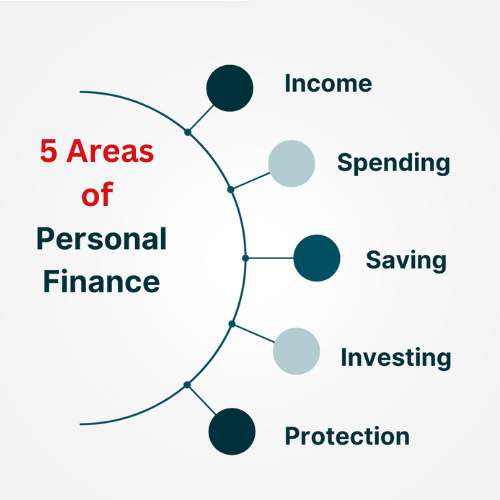Personal finance can often feel like an overwhelming enigma in today’s fast-paced world. The constant influx of bills, options for saving, and investment opportunities can leave even the most organized among us feeling a tad bewildered. However, achieving financial stability and independence doesn’t have to be an arduous task. You can take significant steps towards financial competence and a secure future by breaking down personal finance into five main areas and learning to manage each effectively. Let’s explore these five domains, unpack why they matter, and discuss some actionable strategies for controlling them.
1. Earning: The Foundation of Financial Security
Earning is the cornerstone of personal finance. It’s the source from which all other financial decisions flow. This area encompasses your primary salary, secondary incomes, bonuses, and any other revenue streams you may have.
Control Strategies:
- Enhance Your Skills: Invest in education and training to increase marketability and earning potential. Attend workshops and online courses, or pursue further education that aligns with your career goals.
- Negotiate Wisely: Whether discussing salaries, raises, or side contracts, don’t shy away from negotiations. Research industry standards and advocate for your worth.
- Diversify Income: Explore side hustles or freelance opportunities that align with your talents or interests. This diversification can provide financial cushioning and growth opportunities.
2. Spending: The Art of Frugal Living
Most people feel the pinch when it comes to spending. It’s crucial to develop a keen sense of where your money is going to avoid living paycheck to paycheck.
Control Strategies:
- Budgeting: Create a realistic budget that aligns with your lifestyle and stick to it. There are countless budgeting tools and apps available that can help you track spending and manage bills.
- Prioritize Needs Over Wants: Distinguish between essential expenses and non-essential expenditures. Make deliberate choices to focus spending on needs before wants.
- Practice Conscious Shopping: Avoid impulse buying by implementing a 24-hour rule before making significant purchases and take advantage of discounts, rewards programs, and cash-back offers.
3. Saving: Building Your Financial Cushion
Savings is your hedge against unforeseen expenses and future financial goals. It’s your safety net and a crucial element in planning for long-term stability.
Control Strategies:
- Automate Savings: Set up automatic monthly transfers from your checking account to a savings account, treating savings like another fixed expense.
- Establish an Emergency Fund: Aim to save three to six months’ worth of living expenses to cover emergencies without derailing your financial plans.
- Set Clear Goals: Whether for a vacation, a new car, or retirement, having clear financial goals ensures you’re allocating the right amount toward savings.
4. Investing: Growing Your Wealth
Investing is about putting your money to work for you, helping it grow beyond the capabilities of a traditional savings account through stocks, bonds, mutual funds, real estate, or other investment vehicles.
Control Strategies:
- Educate Yourself: Understanding the basics of investment options and market mechanisms can demystify the process and improve your decision-making.
- Diversify Your Portfolio: Spread your investments across different asset types to minimize risk and maximize potential returns.
- Start Early: The magic of compounding means that even small amounts can grow significantly if invested early and left to accrue over time.
5. Protection: Safeguarding Your Finances
Protection ensures that the wealth you accumulate is safeguarded against potential risks. This includes insurance, wills, and estate planning.
Control Strategies:
- Insurance: Assess your need for health, life, disability, and other forms of insurance to protect yourself and your family from unforeseen circumstances.
- Legal Planning: Establish a will and consider estate planning to ensure your assets are managed and distributed according to your wishes.
- Regular Reviews: Review and adjust your protection strategies to reflect life changes such as marriage, children, or significant purchases.
Conclusion
Mastering personal finance is not an overnight task but a lifelong journey. By understanding and controlling these five key areas—earning, spending, saving, investing, and protecting—you equip yourself with the tools needed to navigate the financial currents of life. Stay proactive, seek professional advice when necessary, and continuously educate yourself to adapt to changing circumstances. With discipline and strategic planning, financial peace of mind is not just a dream but an attainable reality.

